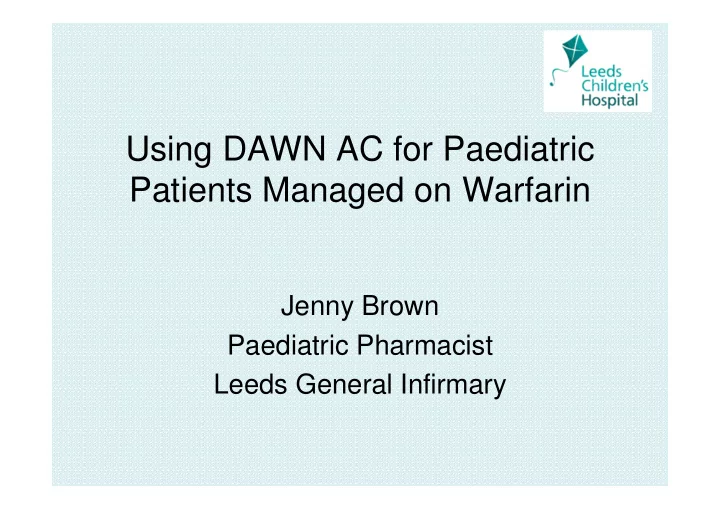

Using DAWN AC for Paediatric Patients Managed on Warfarin Jenny Brown Paediatric Pharmacist Leeds General Infirmary
Overview • Introduction • Background • Dosing considerations for paediatric patients • Benefits of using DAWN AC • Limitations of using DAWN AC • The future
Introduction • Why do we need a dedicated paediatric warfarin clinic? – Practical considerations • High number of paediatric patients on warfarin • No formal anticoagulation service for any paediatric specialty – Clinical considerations • Different pharmacokinetics • Variations in weight-dose and age-dose responses • Frequent intercurrent illnesses • Variable dietary intake • Often on concurrent medication
Background • NPSA Patient Safety Alert 18: Actions that can make anticoagulants safer Old Service New Service Based on acute paediatric Formal, dedicated outpatient ward clinic based in a clinic room Parents phoned on an ad hoc Formal appointment times basis; no follow up if they and follow up if appointment failed to ring missed Paper records kept. No Computerised recording written communication with system (DAWN AC!) which GP/parents. No formal follow does it all! up arrangements.
Indications for Warfarin in Paediatric Patients • Cardiology – Fontan-type circulation – MVR/AVR – Kawasaki’s disease • Neurology – Venous sinus thrombosis • Hepatology – Shunts • Haematology – Thrombosis
Dosing Considerations in Paediatric Patients • Seemingly insignificant changes can affect the INR • Seem to be more sensitive to changes in dose • Require more frequent monitoring – Growth spurt – Vaccines – Term time vs. school holidays – Puberty – Menstruation – Feeding regimes
Risk class highlights whether patients have their INR taken in hospital or at home using a Coaguchek machine Information on who to contact for INR result or other important information Comment box for relevant information relating to that appointment’s dosing
Any dosing information outside the dosing algorithm is written in the comments section
Benefits of Using DAWN AC (v7.6) • Up to date record of anticoagulation history • Documentation of all INRs and dosing recommendation • Written communication to GPs and parents/carers • Formal follow up arrangements • Audit
Limitations of Using DAWN AC (v7.6) • Unable to distinguish between adult and paediatric patients • Dosing – Adult algorithm • Warfarin half mg regime doesn’t allow alternate daily dosing >5mg • Can’t do three day alternating regime – Therefore not recorded on letter, have to alter by hand – Only acknowledges tablet preparation, not suspension (not used at LTHT) • Frequency of testing – Not always appropriate for paediatrics • Concommitant medication – Not always listed • Transition to adults • Communication with external systems – Admissions – Payment
The future… • We would like: – Paediatric dosing algorithm – DAWN AC to be able to separate paediatric and adult patients – Communication with other computerised systems • What we will do: – Increase pool of independent prescribers – Publish our experiences to promote the use of computerised dosing systems
Recommend
More recommend